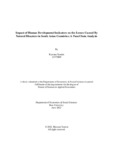Impact of Human Development Indicators on the losses caused by natural disasters in South Asian Countries: A panel data analysis

View/Open
Date
2022-06Publisher
Brac UniversityAuthor
Tasnim, RijwanaMetadata
Show full item recordAbstract
A large number of natural disasters hit the South Asian region every year taking away many
lives, damaging million dollars’ worth properties, crop lands, livestock and leaving thousands
of people injured and homeless. South Asia faces so many adverse events due to its geoclimatic characteristic but the socio-economic factors i.e. lack of awareness, insufficient
funds for pre and post disaster relief, overloaded population, corruption, poor governance,
weak infrastructures add more to weaken the situation. Though disasters are unpredictable
and they are obvious to happen, some factors are considered in reducing the damages from
disasters. A panel of 5 countries (Bangladesh, India, Nepal, Pakistan and Sri Lanka) covering
period 1981-2019 was used to examine the effect of four explanatory variables – (1)
population density, (2) GDP, (3) education and (4) life expectancy on the (1) total number of
deaths, (2) total number of affected and (3) total financial damages. Using log-log model and
linear panel regression, population density is found to have positive impact on the total deaths
and affected. Life expectancy of birth is negatively related to the number of deaths and
affected as expected. Again, education is found to be positively related to the total affected
but reducing the total deaths and total damages. On the other hand, GDP is found to be
positively related to human loss significantly but to total financial damages negatively.
